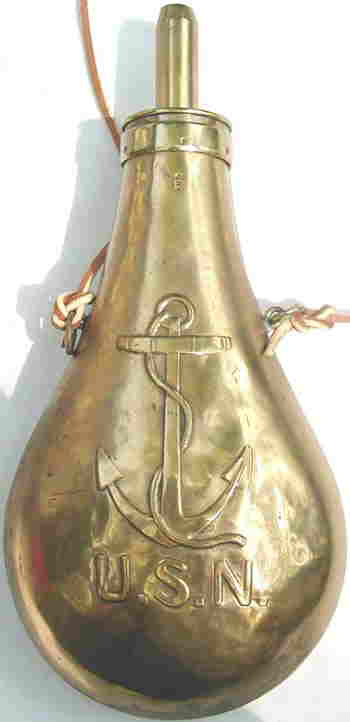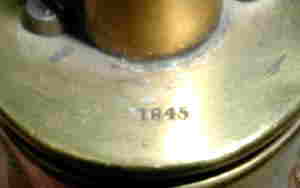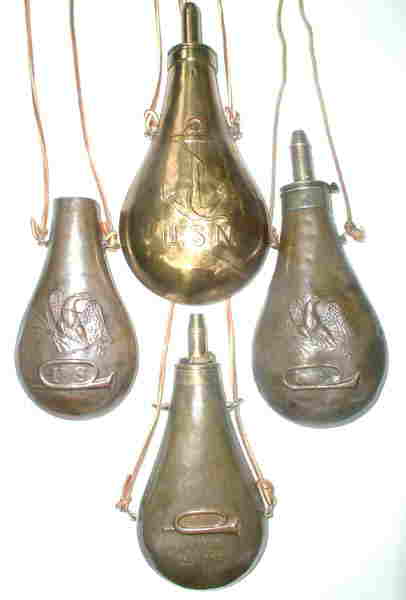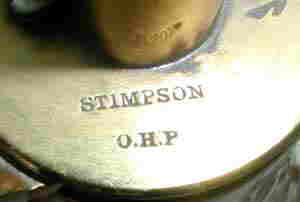|
Part 3 of 3
|
|
| From May 5 to May 14, 2000, the featured Collector's Item of the Week topic was 3 different examples of the U.S. Peace flask. This week we will be looking at the third of three and three-quarters of other U.S. military copper powder flasks. Part 1 was posted on July 20, 2000 and Part 2 on July 27, 2000. The flasks in this three part feature grouping follow: | |
|
|
|
| Top:
An 1845 dated "Fouled Anchor" U.S. Navy flask by Stimpson. (This
week's posting) Center Left: A "topless" 1832 U.S. Rifleman's "Bugle Eagle" flask by Robert Dingee. (See July 27, 2000 posting) Center Right: A complete 1833 dated U.S. Rifleman's "Bugle Eagle" flask by Robert Dingee. (See July 27, 2000 posting) Bottom: An undated 1825 -27 U.S. Rifleman's "Public Property" flask. (See July 20's Collector's Item)
|
|
|
|
|
|
Please note that the definitive work on Powder Flasks, of all types,
is Ray Riling's "The Powder Flask Book" published
in 1953. It is a magnificent tome and it is highly unlikely that
it will ever be surpassed in its breadth and study scope of powder
flasks. Therefore, rather than reinvent the wheel, I have paraphrased
or repeated directly herein some of his comments on the subject
powder flasks. I pray to God that I have done right by Mr. Riling
and can only belatedly thank him for the unbelievable effort he
put into his book and the great and lasting knowledge and benefits
he passed on to the entire world.
|
|
|
|
|
|
With the exception of the "Fouled Anchor" U.S. Navy flask the official
U.S. government powder flasks were intended to be used only for
issue to Riflemen in the Regular Service and to Militia Units. They
may, of course, have been used irregularly with muskets. However,
these flasks along with the Hall rifle flask manufactured at the
Harper's Ferry Arsenal and the later "Peace" flasks, were generally
meant to serve the Model 1803, 1814-20 U.S. flintlock rifle, the
Model 1814 U.S. flintlock rifle, the Model 1817 flintlock "Common
Rifle" and the percussion conversions thereof plus the U.S. percussion
rifle, Model of 1841. The "Fouled Anchor" navy flask was originally
manufactured for use with the Jenks Navy Carbine and the Ames Box
lock single shot pistol.
Two weeks ago, we started with the earliest of the grouping. That
was the James Baker "Public Property" flask of 1825 -1827. Last
week the featured flasks were Robert Dingee's "Bugle Eagle" flasks
of 1832-1833. This week
|
|
|
Inspected by Oliver Hazard Perry |
|
|
A Navy Department order dated December 18, 1844 over the signature of W. M. Crane to J. Y. Mason recorded a contract to George Stimpson for copper powder flasks. The Stimpson Fouled Anchor Navy flasks, dated 1845 are held to be the rarest of this type of flask. No contract quantify is noted in Riling's book.
|
|
|
Prior to the Stimpson contract, "fouled anchor" flasks were supplied
by Ames along with the Ames box lock pistols and the Jenks Navy
Carbines made by Ames at Chicopee Falls, Mass. The Ames flasks are
dated 1843. In 1845, George Adams was awarded a contract for 1,200
copper powder flasks from July to December of 1845. These were concurrent
with an order to Henry Deringer for 1,200 box lock single shot pistols.
The Adams "Fouled Anchor" Navy flasks have appeared with the dates
of 1846 and 1848. The Navy contracts awarded to Ames, Stimpson and
Adams in respective succession bear dates from 1843 to 1848.
|
|
|
|
|
|
The 1845 dated Stimpson flask pictured here has been overly cleaned.
It was that way when I got it over 20 years ago at a show in Aledo,
IL. I thought that it might darken up over the years, but it has
not happened. One thing about it is that it appears to be far more
brass than copper. The powder flask book states these flasks to
be copper. But mine certainly appears to be brass. It is just another
question mark found on the collection trail.
|
|

|
|
|
|
|
|
The approximate measurements of this flask are 9-7/8" overall including
the 1-5/8" non adjustable plain spout which is fixed to the top.
The spring is internal to the flask. The width, at the widest point
is 5-1/8". The top diameter is 1½". The "U.S.N." stamping
is 2" wide by 9/16" in height. The 2" measurement includes the period
after the "N". Riling gives a average spout measurement of 65 grains
of powder. The flask will hold 14 ounces of powder. The flask is
dated on the top "1845". directly across from the maker's name,
"STIMPSON". Under the maker's name is the inspector's stamping of
"O.H.P" which stand for Oliver Hazard Perry, a individual of some
note. " O.H.P." is also stamped vertically on the neck of the flask
in line with a "P" stamped horizontally on the flask collar. There
are no other initials or numbers on this flask. Identical "fouled
anchor" and U.S.N. stampings are on both sides of the flask. Riling
notes that he has seen 1 Stimpson flask dated 1844. However, this
flask had a lap-about spring and Riling surmises that it was an
experimental arrangement. The original carrying cords for these
flasks had a loop measuring approximately 28 inches and were fastened
at the rings by a woven seaman-like splice. The size of the loop
would indicate that the flask was carried over a shoulder and hung
beneath the arm pit.
|
|
|
|
|

View of Flask Top Showing 1845 Date |
View of Flask Top Showing Stimpson Name & O.H.P.
|
|
|
|
|
View of "O.H.P." & "P" Markings
|
Close-up of U.S.N. Stamping
|
|
|
|
|
This completes our series on American military copper powder flasks.
Please credit the descriptions used to Ray Riling and give thanks
for his outstanding, one of a kind, powder flask book. My thanks
also go to my son, Reed Radcliffe, the webmaster of this site.
Dave
Radcliffe |
|



